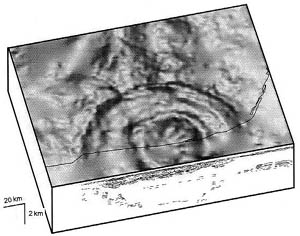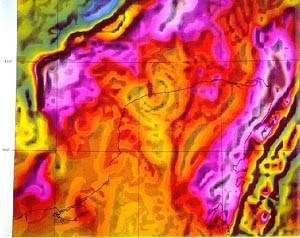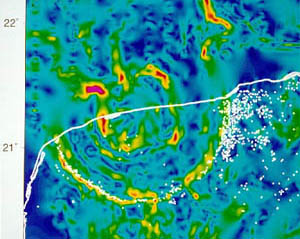|
(6) MORE THAN ONE ASTEROID CAUSED K-T EXTINCTION
The Daily Princetonian, 23 March 2004
http://www.dailyprincetonian.com/archives/2004/03/23/news/9983.shtml
Raj Hathiramani
Princetonian Staff Writer
After years of detective work, University geosciences
professor Gerta Keller and her colleagues have found that an
intensive period of volcanic eruptions and a series of
asteroid impacts likely ended the dinosaurs' reign on Earth,
challenging the dominant theory that a single cataclysmic
asteroid hit caused their extinction.
Though an asteroid or comet could have struck Earth at
the time of the dinosaur extinction, it most likely was,
Keller said, "the straw that broke the camel's back" and not
the sole cause.
For more than a decade, scientists have believed the
Chicxulub crater - submerged off Mexico's Yucatan peninsula
and and more than 110 miles wide - was the remnant of the
dinosaur-killing event.
The time of the dinosaur extinction is known as the
Cretaceous-Tertiary boundary (K-T). Keller's team, working
on the problem since the Chicxulub was identified as the K-T
impact crater, accumulated data and evidence from more than
100 localities that simply did not fit the popular K-T
impact theory.
"We wanted to find out just what the kill-effect of this
impact was, how quickly the mass dying occurred and whether
there were environmental changes preceding it that may have
contributed to the mass extinction," Keller said.
Keller's findings revealed that the asteroid which formed
the Chicxulub crater crashed 300,000 years before dinosaurs
died out. According to Keller, the fateful dinosaur-killer
probably struck Earth somewhere else and remains
undiscovered.
Keller's team, including Thierry Adatte of Switzerland's
University of Neuchatel and Wolfgang Stinnesbeck of
Germany's University of Karlsruhe, obtained samples from a
new core drilled within the Chicxulub impact.
Using radiometricand fossil-dating techniques, the team
examined microscopic rock slices and a 20-inch-thick layer
of limestone sandwiched between impact-formed glass beads
and iridium, an element commonly found in asteroids.
The new core, Keller said, was the decisive factor in
concluding that the Chicxulub impact predated the K-T
boundary, and had nothing to do with the dinosaurs'
extinction.
"We discovered that the impact glass spherule layer that
marks the Chicxulub impact in Mexico and all over Central
America was embedded in the late Maastrichtian sediments
that predated the K-T mass extinction by 300,000 years,"
Keller said.
However, it was Keller's detailed analysis of
microorganisms that gave the team's work real credibility,
University geophysicist Jason Morgan said.
"It's not like finding an isolated dinosaur bone," Morgan
told the Princeton Weekly Bulletin. "You have thousands of
organisms in a single sample. You can do real statistics on
them."
The team also determined that the ecological disruption
from the Chicxulub impact may not have been as severe as
originally believed.
Keller found normal marine sediments directly on top of
the fallout layer, indicating there were no tsunami waves or
other major environmental disturbances.
These results were confirmed by other studies conducted
throughout Mexico, Guatemala and Haiti, which exposed signs
of as many as three meteorite impacts: the Chicxulub impact;
the K-T impact with its iridium layer and mass extinction;
and a third smaller impact, evidenced by another iridium
layer about 100,000 years after the extinction.
Keller is now studying the effects of volcanic eruptions
that began 500,000 years before the K-T boundary and
produced a period of global warming. Findings suggest that
volcanism caused biotic stress almost as great as the mass
extinction itself.
"Asteroid impacts and volcanism may be hard to
distinguish based on their effects on plant and animal life,
and the K-T mass extinction could be the result of both,"
Keller said.
Her results have also helped other scientists understand
the probable effects of greenhouse effect warming resulting
from volcanism and other causes. However, Keller mentions
that her team became unpopular in the process of their work
for challenging a theory that had become so entrenched.
"We plowed on despite opposition, searching for the
truth, searching for what really happened more than 65
million years ago," Keller said.
According to geophysicist Vincent Courtillot at
Universite Paris, the true believers in the "Chicxulub is
the K-T impact killer" theory are strongly opposed by a
number of renowned scientists. Keller does not expect to
ever change the former's minds but foresees her ideas
gaining greater recognition.
"The large majority of us are happy that finally the
spell is broken and that other theories can be considered
with less fear of character assassination that has been the
norm," she said.
Copyright 2004 Daily Princetonian Publishing Company,
Inc. All Rights Reserved.
MODERATOR'S NOTE: Let me see whether I get that right:
Scientists who hold that "Chicxulub is
the K-T impact killer" are dogmatic "true believers",
obstinate pig-heads who will never
change their views regardless of the geological evidence,
horrid people who normally
use "character assassination" instead of arguments. For
goodness' sake, get out of your
glass houses or stop throwing stones. BJP
|


